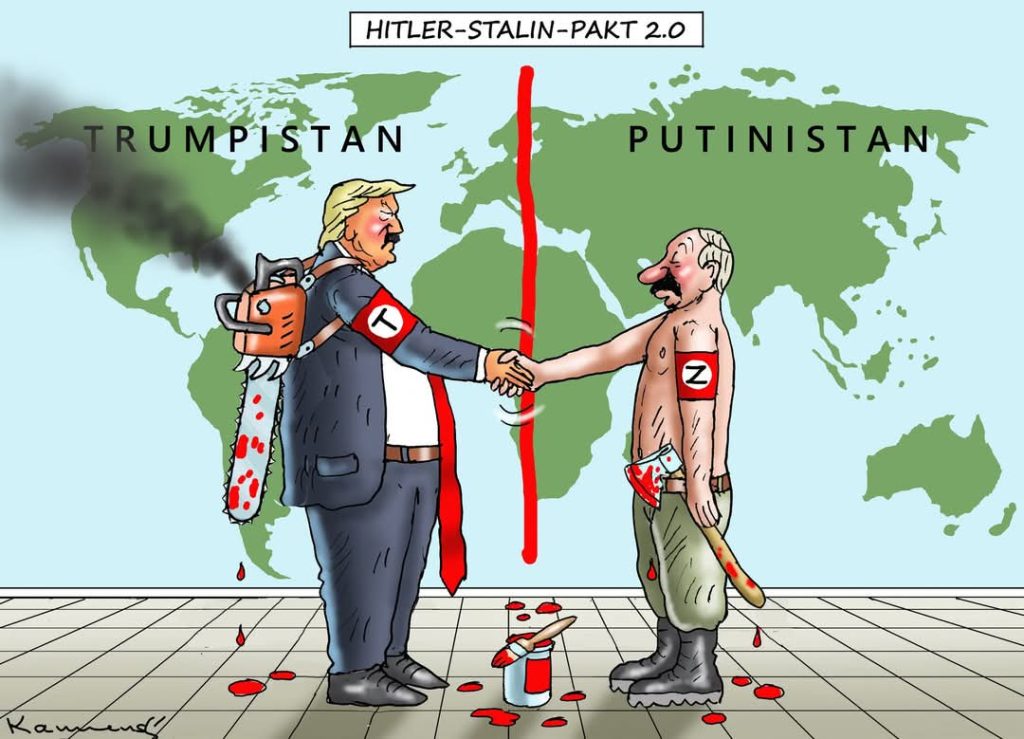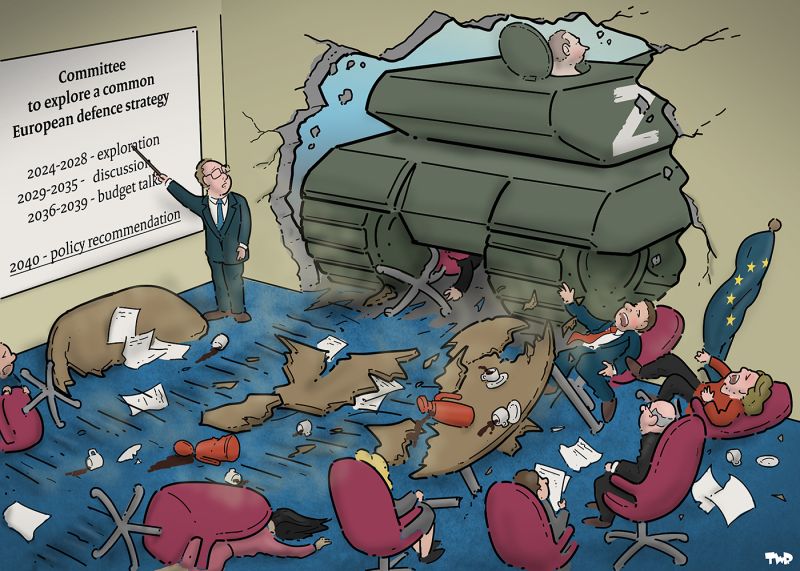Russia and the new U.S. administration have the same goals: to rip apart the EU by supporting extremist parties and destroying Ukraine as the last bastion and notion of the democratic world.
There is a new long read out by Valeriy Pekar, the Ukrainian political analyst. I have only seen the Ukrainian version. It is a very long piece. A colleague has provided a summary in English.
It is brutal, but it is brilliant. He nails all the issues.

20 February 2025 — It took a week to piece together the chaos surrounding us. Now, we finally have a clearer picture. While this text could be supplemented with crucial details that will emerge later, I’m publishing it now to introduce this new reality.
1. The end of the old world order
The world order based on rules, agreements, and values no longer exists. It was never perfect, but it functioned – until now. Explaining its collapse requires a separate analysis, but in short: developed countries benefited from it, while developing ones sought to dismantle it. At some point, these developing nations – led by China – began catching up. Seeing this, the strongest developed nation, the U.S., decided to shift from preserving the old order to actively dismantling it. That’s why the American people elected Trump – he is not an anomaly but the embodiment of this trend.
Before, while some chipped away at the structure, others reinforced it. Now, destruction is happening from both sides, accelerating the collapse. In this “new world without order,” the U.S. will not protect its European or Asian allies. There are no alliances or mutual obligations anymore – only strong nations taking what they want and weak nations suffering the consequences. At least, this is how the new American administration sees it.
They are not isolationists – they are expansionists. Their claims over Greenland, Canada, or Panama should not come as a surprise.
Of course, this administration is not monolithic. It consists of various factions with different values and interests, but two key groups stand out:
• “America First” wants to destroy the old world order but strengthen the American state to dominate globally
• “The Tech Oligarchs” (more accurately, techno-fascists) want to destroy not only the world order but also the American state itself, so their tech corporations can rule unchallenged.
These factions differ on taxes, intelligence agencies, and migration (the Tech Oligarchs need global talent, while America First opposes immigration). They will eventually clash, but for now, they are united in tearing down the old system.
The new America no longer wants to be the world’s policeman. It will not defend democracy, spread education, or develop institutions – it only wants your resources. Previously, this was China’s strategy. Now, America adopts it too.
The U.S. no longer believes in multilateralism or international institutions. NATO, the WTO, or even the UN could soon face American withdrawal. Musk will argue it’s about saving U.S. funds, Trump will call these institutions dysfunctional, and the Project 2025 faction will claim America can handle aid and security without bureaucrats.
2. What this means for Europe
The security pact with Europe – Pax Americana – is over. The U.S. no longer sees Europe as an ally but as a competing power center. America, Russia, and China all share a common interest: weakening, dividing, and dismantling the European Union. They want to break it into isolated, vulnerable markets that can be exploited.
It remains unclear how the U.S. envisions European spheres of influence – whether they will plunder it together or if Western Europe will be America’s exclusive domain while Eastern Europe is handed to Russia (as during the Cold War). But what’s clear is that the EU must be broken apart.
To achieve this, the U.S. openly backs far-right Euroskeptics (Russia supports both the far-right and far-left). If strong individual leaders emerge in post-EU Europe, America will cooperate with them. For now, however, Washington sees no promising candidates in France, Germany, or the UK.
3. What this means for Russia
America views China as its greatest adversary. This has led to what I consider the biggest geopolitical mistake of the 21st century: the belief that Russia can be turned against China.
Every U.S. administration has initially attempted a “reset” with Russia, mistakenly treating it as part of Western civilization. These efforts always failed – but only after much damage was done.
The current American administration’s biggest fear is the collapse of the Russian regime. Preventing this is now a priority. Two years ago, I warned that America’s fear of Russia losing would soon outweigh its fear of Ukraine losing. That moment has arrived.
In his first month in office, Trump ended Russia’s international isolation. Instead of treating it as an aggressor and terrorist state, he presented Russia as a powerful nation that deserves a seat at the table. Sanctions may soon be lifted.
Imagine if, during World War II, the U.S. had sent envoys to meet with Hitler instead of supporting Britain, claiming Poland and France were to blame for their own invasion. That’s where we are now.
4. What this means for Ukraine
First, U.S. support for Ukraine is over – regardless of who wins the next Ukraine election. Some Ukrainians believe parts of the American administration “hate” Ukraine while others “love” it. That’s a childish view. The reality is that Ukraine is simply irrelevant to them. The U.S. now has two objectives:
• Weaken Europe to make it defenseless
• Strengthen Russia to use it against China
Ukraine stands in the way of both goals – so it must be punished.
A new metaphor gaining traction in Washington compares the war to the American Civil War. In this view, Ukraine is a rebellious southern province, and the victorious Union (Russia) will eventually impose order. Foreign powers (the U.S. and EU) should stay out of a “civil war.”
5. What should Ukraine do?
In brief:
• Stop hoping to “win over” the American administration. Ukraine is an obstacle to their plans, not a partner. There is nothing to offer them.
• Accept that U.S. aid is ending. The full consequences will be painful, far beyond the loss of USAID. But there is no way to prevent this.
• Turn to Europe. Europe cannot survive without Ukraine, and Ukraine cannot survive without Europe. They must stand together or fall together.
• Seek allies beyond the U.S. and EU. Turkey is a key player. Other potential allies must be identified. Ukraine must prioritize survival over ideology.
6. Russia’s next move: political war
Since Russia cannot defeat Ukraine militarily, it will try to do so politically.
That’s why pushing Ukraine into elections before a secure peace deal is disastrous. The U.S. and Russia are now aligned in promoting the idea of “elections first, peace later” – because it’s the cheapest way to destroy Ukraine.
If Ukraine collapses, it will not just lose statehood – it will lose millions of lives. Russia will mobilize everyone and launch a new wave of imperial expansion – this time into an undefended Europe.
Trump wants a Nobel Peace Prize. He believes a ceasefire is enough to win it. But even if a peace deal is signed, and then broken, he will only blame Ukraine for rejecting his “greatest peace plan.”
7. What must be done?
In brief:
• Acknowledge the crisis – Ukraine faces an existential threat. Political infighting must end, and leadership must unite the nation in survival.
• Hold a strong, independent stance. Ukraine will not accept any terms that jeopardize its survival
• Improve governance and efficiency in every sector – military, economy, defense industry, and energy
• Mobilize allies while there is still time, with Europe as the priority
And for every Ukrainian:
• Either serve in the army or support it
• Keep a clear mind – don’t fall for Russian propaganda
• Help those in need – resilience comes from unity
As Gandalf once said: “We cannot choose the time we live in. We can only decide what to do with the time given to us”.
* * * * * * * * * * * * * * * * * * * * * * * * * * * * * * * * * * * *
And my own postscript on Europe:
